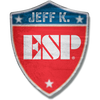ESP Player Bob Kulick to Release "Skeletons In The Closet" Album
ESP Player Bob Kulick to Release "Skeletons In The Closet" Album


Bob Kulick has a musical resume that many of us would dream of. He’s been a go-to sideman, filling the roles of a studio session musician and/or live guitarist, as well as a Grammy-winning producer, songwriter and arranger. Bob has worked with a mind-blowing array of artists that span all musical genres, ranging from KISS (of which his brother Bruce was a member) to Lou Reed to Alice Cooper, Roger Daltrey, Diana Ross, Motorhead, WASP, Meatloaf, and more.
Over that 40-plus year career, one thing Bob hadn’t done is create an album of his own, so when it came time to record this musical project, he called on a few of his friends that he’s worked with. The result, Skeletons In The Closet, will be released later this spring thru Vanity Music Group (Red/Sony) and includes appearances by vocalists including Dee Snider, Robin McAuley, and David Glen Eisley, bass players like Rudy Sarzo, drummers including Vinny Appice, Frankie Banali, Eric Singer, and many others.
Bob, of course, handles the guitar work, and co-produced the album with Bobby Ferrari at Vegas View Recording in Las Vegas, NV. Having been connected to ESP for decades, it’s no surprise that he turned to his killer collection of ESPs to make the album happen.
Tell us more about what to expect on Skeletons In the Closet.
It’s half brand new material with my high profile artist friends, and half songs from Murderer's Row and Skull, two of my previous bands. After finishing the five new songs, the idea of including five of what I consider to be the coolest songs from my past which stylistically fit with the new songs seemed right. Altogether there are 23 singers and musicians on these ten songs.
What are some of the ESP models you used to create these tracks?
One of the main guitars I used was my cool red ESP Viper, with Duncan JB pickups. Each time I used it on a track, it gave it the attack and clarity that was needed. I also turned a lot to what I call my “Skull” guitar. It’s an ESP Custom Guitar that I’ve been using for 20 years, and has a custom skull graphic on the pickguard.
Anything else?
I also used my sparkle Eclipse, and my black Eclipse with a Floyd Rose setup and my ESP GL-56. We did a metal version of "Goldfinger”, the James Bond movie theme song. When everyone heard those first guitar chords in the intro, the major seventh chords et cetera, they couldn’t believe it, hearing that attack. Those guitars sound incredible. It’s a blend of the Viper and the GL-56.
Equally important is how these guitars stay in tune up and down the neck when set up properly with custom tunings. They shine under the microscope of the recording process.

Some of Bob Kulick's collection of ESPs used on his upcoming album include (left-to-right) his ESP "Skull" custom, an LTD Viper-1000, an ESP Eclipse with Floyd Rose, an ESP Eclipse in Silver Sparkle finish, and an ESP GL-56 George Lynch Signature Series.
You’ve had an incredibly successful career as a sideman and studio cat. What prompted you to want to do your solo album at this point?
The writing part actually began in 2014 at my studio in Van Nuys, and then became songs when keyboardist Doug Katsaros, my former bandmate from Balance and Dee Snider, wrote amazing lyrics and melodies to my music in 2015.
I’d met producer Bobby Ferrari in Las Vegas, and he wanted to produce my CD after I played him these songs. I got to work with an incredible producer/engineer, and got to use his awesome studio, Vegas View Recording.
From there, the concept of which artists to use on each track became the challenge. The more important aspect of making the album was that with good songs and my artist friends, we were able to make something special that everyone is excited to be a part of. I can’t wait for everyone to hear it. When a guy like you is looking into a new guitar, what’s the most important aspect you notice right away? Tone? Feel? Design aesthetics?
When a guy like you is looking into a new guitar, what’s the most important aspect you notice right away? Tone? Feel? Design aesthetics?
For me, I always start the same way. I don’t want to hear it plugged in. I want to hear what it’s capable of doing all by itself, unplugged. Each time, I know whether I like it or not right away. I know immediately.
I need to be comfortable with it. There are a few things I do where I check out its sustain, or go for a high note bend. It’s gotta be able to do that for me. What I need is a guitar that’s a high-quality instrument all the way up and down the neck. I’m a schooled player, and the guitar has to perform at the level I need it to. I’m not just doing AC/DC songs.
Do you get inspired by new guitars?
To be honest, some of the best work I’ve ever done happened from picking up an unfamiliar instrument. That’s what happened on Lou Reed’s record. He handed me his personal guitar and said, “Play this.” I did, and it brought out stuff I’d never played before.
I know you and your brother Bruce have been connected to ESP for a very long time. How did that originally come about?
I’ve know Matt (Masciandaro, ESP president) from the 48th Street days back in New York. My brother and I go back to that time period. Matt was over here at this place, DiMarzio was over there. All the guitar players would be hanging out there — Steve Stevens, C.C. DeVille, me — the whole New York clan who hung around 48th street.
 It started with getting a neck here, a body there. By the time I was playing guitar with Paul Stanley on his 1989 solo tour, ESP was producing lots of guitars. I remember looking up on the wall and saying, “What about that guitar?” It had a cool race car graphic. It was unique looking, and after I played it I wanted it immediately, so my infatuation with these guitars kept growing
It started with getting a neck here, a body there. By the time I was playing guitar with Paul Stanley on his 1989 solo tour, ESP was producing lots of guitars. I remember looking up on the wall and saying, “What about that guitar?” It had a cool race car graphic. It was unique looking, and after I played it I wanted it immediately, so my infatuation with these guitars kept growing
What advice do you have for players who hit that learning plateau and are stuck in the rut of finding it hard to improve?
You need to think of it the same way a baseball player does. He needs to practice in order to catch up to that 90mph fast ball. It’s the only way to improve. It doesn’t happen by itself. Until you’re at a point where you can comfortably do everything you want to do, you need to admit that you’re not Jimmy Page, or whoever your idol is. You need to practice and get some experience.
The ultimate goal is to get to a point where you’re no longer just emulating other people’s playing styles. All the work and practice that I did helped me get to a point that I felt like I was playing myself, rather than imitating others.
Photos courtesy of Julie Bergonz
My recent favorite Skeletons In The Closet album and love to see this is getting the popularity same like any other tv shows, movies, and music videos. MediaBox HD App iOS is a similar application to watch all his shows at one place. Love you, hero.
Pretty cool album. Watch all latest movies, TV shows, Music videos and series for free on Android and iOS devices using Mediabox HD. All movies and TV shows are available for free on this app.






